Jul 1, 2019 | coins, commemorative, legislative
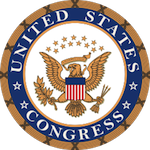 Even while other things were going on, Congress found time to introduce and vote on numismatic-related legislation during the mother of June. The most significant development was the passing of the Women’s Suffrage Centennial Commemorative Coin Act (S. 1235) by unanimous consent.
Even while other things were going on, Congress found time to introduce and vote on numismatic-related legislation during the mother of June. The most significant development was the passing of the Women’s Suffrage Centennial Commemorative Coin Act (S. 1235) by unanimous consent.
If passed by the House of Representatives and signed by the President, the bill would create a commemorative silver dollar in 2020 with a surcharge of $10 per coin that will go to the Smithsonian Institution’s American Women’s History Initiative.
When this bill was sent out of committee to the floor for a vote, the media was all in a twitter (pun intended) about the bipartisan nature of the bill’s support. The bill was introduced on April 30, 2019, by Sen. Marsha Blackburn (R-TN) and cosponsored by every female senator. Subsequently, male senators added their support to where the bill had 82 cosponsors. While we live in very partisan times, those of us who watch numismatic-related legislation understands that these bills are not controversial and tend to gain bipartisan support.
The bill is being held at the desk in the House of Representatives and not assigned to a committee. Although a call to the House did not provide answers, a source says that it is being held for procedural reasons.
According to the source, an objection was made by a member because the member believes that the bill violates the constitution. According to Article I Section 7 of the United States Constitution, it says that “All bills for raising revenue shall originate in the House of Representatives.” Since commemorative coin bills raise revenue for private and public (seigniorage) sources, someone believes that the Senate overstepped its bounds.
There was no report as to who filed the objection.
S. 1235: Women’s Suffrage Centennial Commemorative Coin Act
Held at the desk. — Jun 5, 2019
Received in the House. — Jun 5, 2019
Message on Senate action sent to the House. — Jun 5, 2019
Passed Senate with an amendment by Unanimous Consent. — Jun 4, 2019
Senate Committee on Banking, Housing, and Urban Affairs discharged by Unanimous Consent. — Jun 4, 2019
Read twice and referred to the Committee on Banking, Housing, and Urban Affairs. — Apr 30, 2019
H.R. 3155: 75th Anniversary of the End of World War II Commemorative Coin Act
Summary: This bill directs the Department of the Treasury to mint and issue up to 50,000 $5 coins, 500,000 $1 coins, and 750,000 half-dollar coins in commemoration of the 75th anniversary of the end of World War II.The coins shall be emblematic of the sacrifices made by millions of people of the United States 75 years ago in bringing an end to World War II. The design on each coin shall represent the World War II Victory Medal, which was awarded to all 16 million U.S. military personnel who served from December 7, 1941, to December 31, 1946.The bill requires all sales of such coins include specified surcharges, which shall be paid by Treasury to the congressionally designated National WWII Museum to fund its educational mission of telling the story of the U.S. experience in World War II.
Referred to the House Committee on Financial Services. — Jun 6, 2019
S. 1794: CENTS Act
Read twice and referred to the Committee on Banking, Housing, and Urban Affairs. — Jun 12, 2019
H.R. 3483: To require the Secretary of the Treasury to mint commemorative coins in recognition of the 75th anniversary of the integration of baseball.
Referred to the House Committee on Financial Services. — Jun 25, 2019
S. 1954: A bill to require the Secretary of the Treasury to mint commemorative coins in recognition of the 75th anniversary of the integration of baseball.
Read twice and referred to the Committee on Banking, Housing, and Urban Affairs. — Jun 25, 2019
S. 2042: A bill to require the Secretary of the Treasury to mint coins in commemoration of the National Purple Heart Hall of Honor.
Read twice and referred to the Committee on Banking, Housing, and Urban Affairs. — Jun 27, 2019
Jun 23, 2019 | coins, news
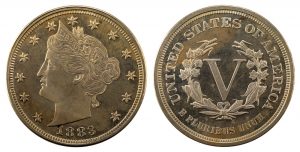
1883 Liberty Head Nickel — Type 1, No “CENTS” on reverse (Credit: National Numismatic Collection, National Museum of American History)
The article talks about the dealer’s held belief that successful coin collecting is about the hunt for the perfect coin. It is finding the right coin for your collection then making it better. Unfortunately, the more this industry holds on to these notions, they are scaring off potential collectors.
What the article and dealers do not want to tell you that it is perfectly acceptable to pick a set, topic, or series and find examples that are good or consistent with the rest of the collection. They tell you that you have to buy the coin in the latest piece of plastic with the highest number and graffitied with stickers. But what they do not tell you is that you can find better-looking coins at lower grades and many times without stickers or entomb in plastic.
One of the best looking collection I saw was a Liberty Head “V” Nickel set with all of the coins in extra fine (XF) condition. It is a more difficult collection to assemble than one might think. These coins were the workhorse of the economy. Their copper-nickel alloy was softer than the silver coins and wore quickly. It is challenging to find 19th-century coins in XF condition.
The set will not bring its assembler a lot of profit since the Liberty Head nickel is not in high demand. Instead, it is an accomplishment by a dedicated collector whose goal was to have fun.
Maybe that is the key to promoting the hobby. Let’s have some fun and stop worrying about what is the right or wrong way to collect!
And now the news…

June 18, 2019
A gold coin that dates back to ancient Rome and was discovered in a field by a man with a metal detector has sold at auction for nearly $700,000. 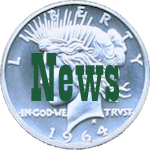 → Read more at jckonline.com
→ Read more at jckonline.com

June 20, 2019
Why not get the kids off the computer and into something of lasting value?  → Read more at desertsun.com
→ Read more at desertsun.com

June 20, 2019
The archaeological excavations in Parion, a well-protected ancient city in Çanakkale, aim to shed light on the defense system of the city  → Read more at hurriyetdailynews.com
→ Read more at hurriyetdailynews.com

June 20, 2019
Mickey Mantle and Hank Aaron were among the impressive collection.  → Read more at silive.com
→ Read more at silive.com

June 21, 2019
LANSING, Mich. — While attending the International Paper Money Show in Kansas City, Missouri late last week, the staff of Liberty Coin Service purchased an exceedingly rare 1736 mortgage document for land in Mooreland, Pennsylvania Province that was printed by Benjamin Franklin.  → Read more at fox47news.com
→ Read more at fox47news.com
Jun 21, 2019 | cents, coins, fun, video
This one is just for fun.
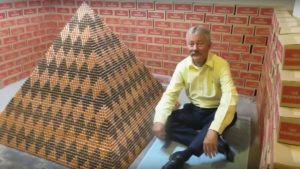
Cory Nelson poses with his World Record creation (screen grab from YouTube)
In an interview with CBC Radio, Nelson said that after building a coin pyramid with 41,000 coins on his desk, his coworkers asked if it was the world’s largest. He said that if it were not, he would make sure it is.
According to the Guinness World Records, the record was 1,000,935 Lithuanian one-cent coin by Vytautas Jakštas and Domas Jokubauskis. The pair built their coin pyramid in 2014 using Lithuanian Litas as a celebration before Lithuania converted to the Euro.
After three years of work on it for 20 hours per week, 45 YouTube videos tracking his work, and 1,030,315 Lincoln cents later (that is $10,303.15 worth of coins), Nelson submitted his creation to become the world records holder. It will take a while for GWR to verify the record.
Here’s the final video of Nelson’s pyramid:
Jun 6, 2019 | coins, commemorative, legislative
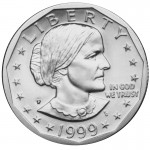 Congress may be filling out the 2020 commemorative coin calendar with the Senate passing the Women’s Suffrage Centennial Commemorative Coin Act (S. 1235). If passed by the House, the bill would require the U.S. Mint to issue a one dollar silver coin to commemorate women suffrage activists in 2020.
Congress may be filling out the 2020 commemorative coin calendar with the Senate passing the Women’s Suffrage Centennial Commemorative Coin Act (S. 1235). If passed by the House, the bill would require the U.S. Mint to issue a one dollar silver coin to commemorate women suffrage activists in 2020.
S. 1235: Women’s Suffrage Centennial Commemorative Coin Act
Passed Senate with an amendment by Unanimous Consent. — Jun 4, 2019
Senate Committee on Banking, Housing, and Urban Affairs discharged by Unanimous Consent. — Jun 4, 2019
Read twice and referred to the Committee on Banking, Housing, and Urban Affairs. — Apr 30, 2019
On August 18, 1920, Tennessee became the 36th state to ratify the 19th Amendment to the U.S. Constitution. Since there were 48 states in the union, 36 represented the three-quarters necessary to ratify the amendment.
S. 1235 was introduced in the Senate by Sen. Marsha Blackburn from Tennessee.
According to the bill the design of the coin is supposed to “contain motifs that honor Susan B. Anthony, Elizabeth Cady Stanton, Carrie Chapman Catt, Harriet Tubman, Mary Church Terrell, Alice Paul, Lide Meriwether, Ida B. Wells, and other suffrage activists of the late 19th century and early 20th centuries.” That is a lot of people to try to fit on a 1½-inch coin.
As with almost every other commemorative coin bill, the silver dollar will have a $10 surcharge. The surcharge will go to the Smithsonian Institution’s American Women’s History Initiative.
This bill does not mention mintage limits. It is possible to become the most produced commemorative coin of the modern era.
Next, the bill is sent to the House of Representatives for their vote.
Jun 3, 2019 | coins, commemorative, legislative, US Mint
 The legislative review is back after taking a month hiatus since there was nothing to report for April.
The legislative review is back after taking a month hiatus since there was nothing to report for April.
Legislation introduced in May is a bit different than others in that only one bill directly affects the section of the law that governs the U.S. Mint (Subchapter III of chapter 51 of title 31, United States Code). Let’s look at each of legislation submitted in May.
S. 1300: National Law Enforcement Museum Commemorative Coin Act
Read twice and referred to the Committee on Banking, Housing, and Urban Affairs. — May 2, 2019
The National Law Enforcement Museum Commemorative Coin Act is a typical three-coin commemorative coin legislation ($5 gold, $1 silver, half-dollar clad) to raise money for a cause. If passed, this law will pay the surcharges to National Law Enforcement Officers Memorial Fund.
H.R. 2559: Gold Reserve Transparency Act of 2019
Referred to the House Committee on Financial Services. — May 7, 2019
The Gold Reserve Transparency Act of 2019 calls for a complete assay, inventory, and audit of gold reserves held by the federal government. The proposed law requires that the location of all gold is documented “including any gold in ‘deep storage,'” the security of those places, and any transactions of that gold.
If enacted, the Comptroller General of the United States do this audit for the past 15 years and have it completed within 12 months and every five years. The law would require the complete audit to be made public with the only exception of the physical security issues.
COMMENTARY: Given the nature of the economy and a lot of other factors are the gold holds that important? The Federal Reserve reports that the M1 money supply is over $3.7 trillion and the M2 is over $14.5 trillion. Think of the M1 as cash used in commerce. The M2 represents all money, including those in savings, securities, or may have circulating restrictions. Even if the government were to account for every grain of gold as reported an in U.S. Mint’s annual reports, that would represent less than 1-percent of the M1.
Gold holdings are irrelevant to the strength of the United States economy. Maintaining the M1 supply is more critical because it is a measure of activity. Economists fear wild tariffs since it will have a direct effect on the M1 money supply. Changes to the M1 will alter the demand for the products produced by the U.S. Mint and Bureau of Engraving and Printing.
H.R. 2558: To define the dollar as a fixed weight of gold.
Referred to the House Committee on Financial Services. — May 7, 2019
H.R. 2558 would require the Secretary of the Treasury “define the dollar in terms of a fixed weight of gold, based on that day’s closing market price of gold” and allow Federal Reserve Notes to be exchangeable for gold at that statutory rate.
COMMENTARY: This is a backhanded attempt to return the United States to the gold standard without the sufficient backing of gold that will support this effort. With the money supply being over $14 trillion, trying to match the amount of gold at market value to every U.S. dollar would cause a devaluation of the currency that it would not be economically viable to do business in or with the United States.
Further, the market price of gold is set by private banks, metals dealers, mining companies, and other financial companies from all over the world through the London Bullion Market Association (LBMA). Given the makeup of their membership, this bill will allow this market that includes people from Bahrain, China, Switzerland, Russia, and other countries where the United States may have disputes to have direct influence over the strength of the U.S. dollar.
The introduction of a bill like this makes for good talking points for a constituency that is ignorant of the ramifications of this law. It is not sound policy given the nature of the markets.
H.R. 2630: Cash Always Should be Honored Act
Referred to the House Committee on Energy and Commerce. — May 9, 2019
The Cash Always Should be Honored (CASH) Act states that “It shall be unlawful for any physical retail establishment to refuse to accept legal tender as payment for any products or services offered for sale by such physical retail establishment.” The bill allows exemptions for online and telephone-based transactions.
COMMENTARY: Although I believe in the power of spending the products of the U.S. Mint and Bureau of Engraving and Printing over using electronic means, it should not be the government’s place to tell anyone how to conduct business.
Another short-sighted bill that does not consider the modern economy because it does not consider changes to the concept of a physical retail establishment. For example, what about mobile-based commerce? Would the rideshare companies be required to take cash? What about the plumber who comes to fix your sink? What about the food truck where you might buy lunch?
For the numismatists, how would this affect dealers at a coin show? Will you be required to carry around a wad of currency to buy coins? Would there be a distinction between the dealer who only sells at shows versus a dealer with a shop who travels to shows?
It is another bill that looks better as part of talking points than its effects on the real economy.
H.R. 2650: Payment Choice Act of 2019
Referred to the House Committee on Financial Services. — May 9, 2019
This Payment Choice Act of 2019 is similar to the CASH Act in that it will prohibit any business from refusing “to accept United States legal tender of cash as payment for goods or services,” post signs saying that the establishment will not accept cash, or charge a higher price for paying in cash. The bill exempts “any goods or services sold to the public by telephone, mail, or internet.”
COMMENTARY: See the commentary for the CASH Act, above.
Jun 2, 2019 | Canada, coins, silver, US Mint
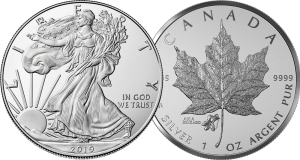 The most interesting news of the week was not printed by a media outlet but by the Government Printing Office. On May 23, 2019, the GPO published an entry in the Federal Register saying that the U.S. Mint has priced the Pride of Two Nations Limited Edition Two-Coin Set at $139.95.
The most interesting news of the week was not printed by a media outlet but by the Government Printing Office. On May 23, 2019, the GPO published an entry in the Federal Register saying that the U.S. Mint has priced the Pride of Two Nations Limited Edition Two-Coin Set at $139.95.
Which two nations? Of course, if this is coming from the U.S. Mint, one of the countries is the United States. However, several reports claim that the second nation is Canada.
According to a source, the set will include a proof one-ounce American Silver Eagle coin and a proof one-ounce silver Canada Maple Leaf with a unique privy mark. There was no further information as to what the privy mark will be.
Production will be limited to 250,000 sets, according to the source.
The coins will be packaged and marketed by the U.S. Mint. The Royal Canadian Mint will also take orders for the set that will be fulfilled by the logistics contractor working for the U.S. Mint.
The source did not have information about the packaging.
The set will go on sale at the beginning of the World’s Fair of Money via Internet and telephone ordering only. Falling under the category that we can no longer have nice things, the U.S. Mint’s reticence to open sales at shows is a result of the fiasco that occurred when they released the 2014 50th Anniversary Kennedy Half-Dollar Gold Proof coin at that year’s World’s Fair of Money.
Of course, no dealer was penalized by the American Numismatic Association for disrupting the World’s Fair of Money or setting the conditions that disrupted the distription outside of the Denver Mint.
And now the news…

May 28, 2019
ST. GEORGE — Glen Canyon National Recreation Area’s investigation of centuries-old Spanish coins that were turned into the park has provisionally concluded the coins are authentic. However, according to a news release from the National Park Service, the two small coins were probably part of a modern coin collection, perhaps accidentally or intentionally dropped by a visitor to Lake Powell.  → Read more at stgeorgeutah.com
→ Read more at stgeorgeutah.com

May 29, 2019
Editor's note: This story has been updated to include the newest mock-up of the Harriet Tubman currency from the advocacy group Women on 20s. WASHINGTON – The Trump administration says it needs until 2028 to release a new $20 bill featuring abolitionist hero Harriet Tubman.  → Read more at usatoday.com
→ Read more at usatoday.com

June 1, 2019
The coins and a silver ingot, believed to be worth £500,000, were seized in Durham and Lancashire.  → Read more at bbc.com
→ Read more at bbc.com

June 1, 2019
Is the current 1p piece the least valuable British coin since the currency was unified in 1707?  → Read more at bbc.com
→ Read more at bbc.com
May 28, 2019 | coins, fun, quarter, US Mint
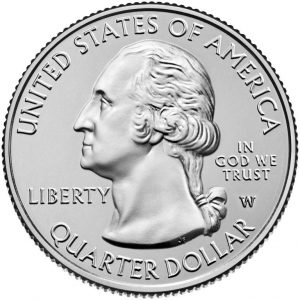 W is more than the 23rd letter of the Latin-based alphabet. While it is the chemical symbol for tungsten and used as an abbreviation for watt, in numismatics, it is an elusive mintmark found on only by a few dedicated hunters.
W is more than the 23rd letter of the Latin-based alphabet. While it is the chemical symbol for tungsten and used as an abbreviation for watt, in numismatics, it is an elusive mintmark found on only by a few dedicated hunters.
With 2 million quarters produced by for each of the five National Parks Quarters issued in 2019, it represents from 0.5 to 1-percent of the total production for each coin. Yet being in the shadows of the nation’s capital and running a business that sees a lot of cash, the only W mint quarters I have found were shown to me by a customer asking about them.
Most of the reports of W mintmark quarter finds have been from roll hunters. They buy rolls from the bank and search. But I have searched the rolls I buy for the shop and not found any W mintmark quarters.
I might offer a bounty for someone bringing one into my shop. I am not sure what I have to trade. I have a roll of 40-percent silver half-dollars I used to give to children when they come in and show an interested in coin collecting. That might be a fair trade!
How about you?

Loading ...
May 26, 2019 | cash, coins, currency, news
In the argument as to whether to get rid of cash in favor of credit cards and electronic payments just took an interesting twist this week. According to a study by LendEDU.com, a website that specializes in loan comparison and education, credit and debit cards are dirtier and carry more germs than currency and coins.
LendEDU reported that they “used a scientific device that tests for bacteria on a given surface.” Their publication did not disclose the device that they used. And based on the results, the tests were performed in New York City.
On average, NYC CitiBike (a bicycle sharing service), McDonald’s door handles, a park bench, and a parking meter had more bacteria than the average credit card. But they did find that the credit card was dirtier than a Penn Station bathroom, cash, coins, and a subway pole.
With all due respect to LendEDU, did they find the most remote bathroom in Penn Station and test it after someone did their quick wipe down? And did they test the pole on the subway car after someone used that bathroom and washed their hands if the sink worked?
Aside from being a proponent for using the products produced by the Bureau of Engraving and Printing and the U.S. Mint, I am a native New Yorker and one-time commuter from Long Island. These findings are difficult to believe, especially the low score for the subway pole. I have taken the A Train. I would not have a sandwich without washing my hands after getting off the train!
It is a fun story but hardly a credible test.
If you would excuse me, I have to check the level of the big bottle of hand sanitizer next to the cash register!
And now the news…

May 22, 2019
That credit or debit card in your wallet is apparently dirtier than you might have suspected.  → Read more at foxbusiness.com
→ Read more at foxbusiness.com

May 23, 2019
MONTREAL, May 23, 2019 /PRNewswire/ – In 1969, Plastic Ono Band (John Lennon and Yoko Ono) recorded Give Peace A Chance, an anti-war anthem for generations of pacifists and music fans around the world. The song was recorded live from Lennon and Ono’s Queen Elizabeth Hotel suite in downtown Montreal  → Read more at finance.yahoo.com
→ Read more at finance.yahoo.com

May 24, 2019
The recent discovery of two ancient Spanish coins near Halls Crossing excited archaeologists at Glen Canyon National Recreation Area, who wondered whether they offered evidence that Spanish explorers, possibly in search of mythical cities of gold, passed through Utah centuries ago.  → Read more at sltrib.com
→ Read more at sltrib.com

May 25, 2019
A US-made collectable coin lists Britain and France among the honored US allies in WWII, but, strangely, the Soviet Union, whose Red Army delivered a crushing blow to the Nazis in Europe and fought Japan, is omitted.  → Read more at rt.com
→ Read more at rt.com

May 25, 2019
Apparently, the Soviet Union, whose soldiers hoisted a red flag over the Reichstag marking the liberation of most of Europe from the Nazis during World War II, is not a country that contributed to securing the "liberties" the Western states "enjoy today", per a US company which issued a souvenir commemorating the victory's upcoming anniversary.  → Read more at sputniknews.com
→ Read more at sputniknews.com
May 19, 2019 | Australia, coins, news

A Kilwa Coin similar to those found on the beach in Australia (Source: news.com.au)
In recent years, the coins have sparked interest in understanding how they ended up in Australia. Even though they are from a time after the arrival of the Aboriginal people, it presents questions as to whether there were other European settlers before James Cook.
Coins are not only a holder of value; they are also a representation of art, history, and commerce. Coins tell us more about our lives than history, which is written by the victors and not the ordinary people who may have done more to guide history than those whose writings may be less than accurate for their glory or the glory of their sponsors. Nowadays, we call that spin.
If finding five coins on a beach in a remote fishing spot in Australia can rewrite history, what will the coins in our pockets tell future generations about us? What stories do any of the coins we collect tell? While it may be nice to hold a mint state 19th-century dollar in our hands, what impact did that worn large cent have on history? Or the history of those who used it?
The term “history in your hand” could never be more impactful than the story of those five coins found while fishing in Australia.
And now the news…

May 12, 2019
Who needs a boring coin purse when you can surprise shoppers at the cash register by popping the lid on your miniature rice cooker?  → Read more at soranews24.com
→ Read more at soranews24.com

May 13, 2019
Remember when you were taught Australia was first claimed for the British throne when it was discovered in 1770 by James Cook who promptly declared it “terra nullius”?  → Read more at news.com.au
→ Read more at news.com.au

May 15, 2019
The 10,000-yen (US$92) coin costs a lot more than 10,000 yen.  → Read more at soranews24.com
→ Read more at soranews24.com

May 16, 2019
The Japanese government has announced a new design for the ¥500 coin. The updated version, slated to hit pockets in fiscal 2021, retains the familiar paulownia design but adds a two-tone look and features like microlettering to thwart counterfeiters.  → Read more at nippon.com
→ Read more at nippon.com

May 16, 2019
QUEEN ELIZABETH II has her portrait printed on every UK coin in circulation, as well as on the coinage of many Commonwealth countries. Now, a Royal Mint designer has shed some light on a coin which is a particular favourite.  → Read more at express.co.uk
→ Read more at express.co.uk
May 12, 2019 | coins, news
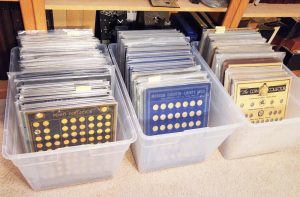
The Midwest Collection of Coin Boards (Image courtesy of David Lange)
Coin boards came before folders and albums. They provided a way for collectors to organize their coin collection. Some dealers used them as an incentive to have people pick coins out of pocket change to sell back to the dealer. The dealer would give the board away with the offer of a reward for bringing it back once it is full of coins.
David Lange is the hobby’s leading expert on coin boards. This past week, Lange announced that he purchased a lot of more than 400 coin boards from a midwest collector dubbed the “Midwest Collection.” The hoard includes several rare coin boards.
Lange’s fascination with coin boards is evident in the three books he has published about them. The most popular is his first book, Coin Collecting Boards of the 1930s & 1940s. It is a recommended book for anyone who wants to know more about numismatic history. He is now selling the book for $19.95 ($14.95 plus $5 for shipping). See his website for more details.
Even if you do not collect coin boards, it is good that there is someone like David Lange to preserve this aspect of the hobby. Otherwise, this aspect of numismatic history would get lost and forgotten. That would be a tragedy.
Congratulation Dave!
And now the news…

May 5, 2019
The U.S. Mint, Washington, suspended its mutilated coin redemption program this May. The U.S.  → Read more at recyclingtoday.com
→ Read more at recyclingtoday.com

May 7, 2019
The Royal Mint has unveiled a series of special £2 coins to mark 75 years since the D-Day landings. The coins pay tribute to those involved in the events on June 6, 1944, which are widely seen as a key turning point in the Second World War.  → Read more at sports.yahoo.com
→ Read more at sports.yahoo.com

May 9, 2019
How did these two coins, believed to be Spanish pieces dating to the 13th century, get to Glen Canyon NRA?/NPS  → Read more at nationalparkstraveler.org
→ Read more at nationalparkstraveler.org

May 10, 2019
The Royal Mint produced no £2 or 20p coins in 2017 as people used change in a rush to get rid of their pound coins as the old ones went out of circulation.  → Read more at telegraph.co.uk
→ Read more at telegraph.co.uk

May 11, 2019
Experts believe they may have found a Kilwa coin that could change what we know about the history of global trade  → Read more at theguardian.com
→ Read more at theguardian.com

May 12, 2019
JapanToday Higashi-Azabu IS bldg, 4F 1-8-1 Higashi-Azabu Minato-ku Tokyo 106-0044 Japan Tel: +81 3 5561 7755 Fax: +81 3 5561 7756 Email: editor@japantoday.com ©2019 GPlusMedia Inc.  → Read more at japantoday.com
→ Read more at japantoday.com

May 12, 2019
More than 3,000 4th Century Roman coins were found in a buried pot in Lincolnshire.  → Read more at bbc.com
→ Read more at bbc.com
 Even while other things were going on, Congress found time to introduce and vote on numismatic-related legislation during the mother of June. The most significant development was the passing of the Women’s Suffrage Centennial Commemorative Coin Act (S. 1235) by unanimous consent.
Even while other things were going on, Congress found time to introduce and vote on numismatic-related legislation during the mother of June. The most significant development was the passing of the Women’s Suffrage Centennial Commemorative Coin Act (S. 1235) by unanimous consent.
 → Read more at
→ Read more at 





